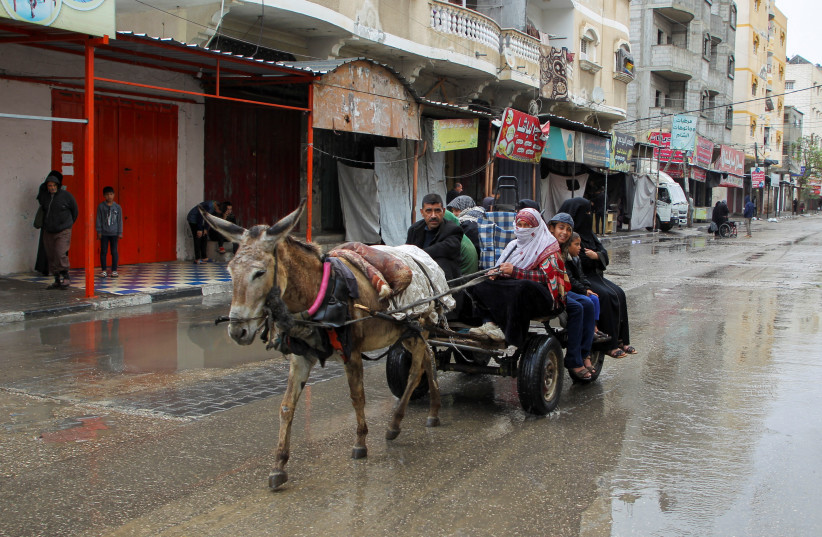The new humanitarian zone includes field hospitals, tents, and increased provisions of food, water, medicine, and other supplies.
TZVI JOFFRE MAY 6, 2024 07:26
Updated: MAY 6, 2024 11:16

The IDF has begun evacuating civilians from eastern Rafah to a new expanded humanitarian zone which includes al-Mawasi and parts of Khan Yunis and central Gaza, the IDF announced on Monday morning. The evacuation comes ahead of planned IDF operations in the Rafah area.
The new humanitarian zone includes field hospitals, tents, and increased provisions of food, water, medicine, and other supplies.
Additionally, the IDF is working in cooperation with international organizations and several countries to allow an increase of humanitarian aid into the Gaza Strip.
The IDF, in accordance with a decision made by the political echelon, is calling on the population currently under Hamas control to evacuate temporarily from the eastern neighborhoods of Rafah to the new zone. The evacuation will be conducted in a phased manner in accordance with continuing situation assessments.

People flee the eastern parts of Rafah after the Israeli military began evacuating Palestinian civilians ahead of a threatened assault on the southern Gazan city, amid the ongoing conflict between Israel and Hamas, in Rafah, in the southern Gaza Strip May 6, 2024. (credit: REUTERS/Hatem Khaled)
The call to evacuate is being made through leaflets, text messages, phone calls, and statements in Arabic.
“The IDF will continue to operate in order to realize the goals of the war, including the dismantling of Hamas and the return of all the hostages,” said the IDF.
الإحتلال يقوم بإلقاء منشورات على مدينة رفح هذه اللحظات pic.twitter.com/yUExvL1lRV
— عَبدالـرحمن | غـزة (@aboodka_04) May 6, 2024
Shortly after the IDF announcement, Palestinian media reported that the IDF began dropping leaflets over Rafah informing civilians about the evacuation. The leaflets warned that Gaza City is still off limits and considered a “dangerous combat zone” and that it is “forbidden to approach the eastern and southern security fence.”
The leaflets, published by the IDF as well, noted that the IDF would act with “extreme force” against terrorist organizations in the areas under the evacuation order. “Anyone who is near terrorist organizations puts his life and the life of his family at risk,” warned the leaflets.
Witnesses on the ground told Reuters on Monday morning that some families had begun evacuating the area under the evacuation order.
شاهد | استمرار العمل في معبر رفح البري ودخول حافلات المسافرين. pic.twitter.com/2Fh6Sfmwb4
— وكالة شهاب للأنباء (@ShehabAgency) May 6, 2024
The General Authority for Crossings and Borders said that the Rafah crossing was still operating as usual, after some reports by Arabic media stated that the crossing was closed.
Evacuation for limited area, US informed of decision
The evacuation was for a limited area as of Monday, including an area where about 100,000 people are believed to be staying at the moment, according to Israeli media.
The cabinet decided on the evacuation on Sunday night, with Defense Minister Yoav Gallant informing US Secretary of Defense Lloyd Austin about the decision overnight.
During the discussion, Gallant also informed Austin about the rocket barrage fired at Kerem Shalom. The defense minister detailed the efforts the government made toward trying to reach a ceasefire and hostage release deal, insisting that, at this stage, Hamas was refusing all proposals.
Gallant stressed during the conversation that “there was no choice left, and this meant the start of the Israeli operation in Rafah.” Gallant thanked Austin for the close cooperation between Israel and the US.
A readout of the call published by the US Department of Defense overnight said that the two discussed the ongoing hostage negotiations, humanitarian aid efforts, and Rafah. Austin expressed his condolences for the IDF soldiers killed in the rocket attack on Kerem Shalom and reaffirmed his commitment to the unconditional return of all the hostages.
Austin stressed that any potential military operation in Rafah needed to include a “credible plan to evacuate Palestinian civilians and maintain the flow of humanitarian aid.”
The decision to launch the evacuation came after Hamas fired a barrage of rockets from Rafah towards the Kerem Shalom area on Sunday, killing three soldiers and wounding ten others. The area being evacuated includes the area where the rockets were fired from.
Content retrieved from: https://www.jpost.com/breaking-news/article-800026.